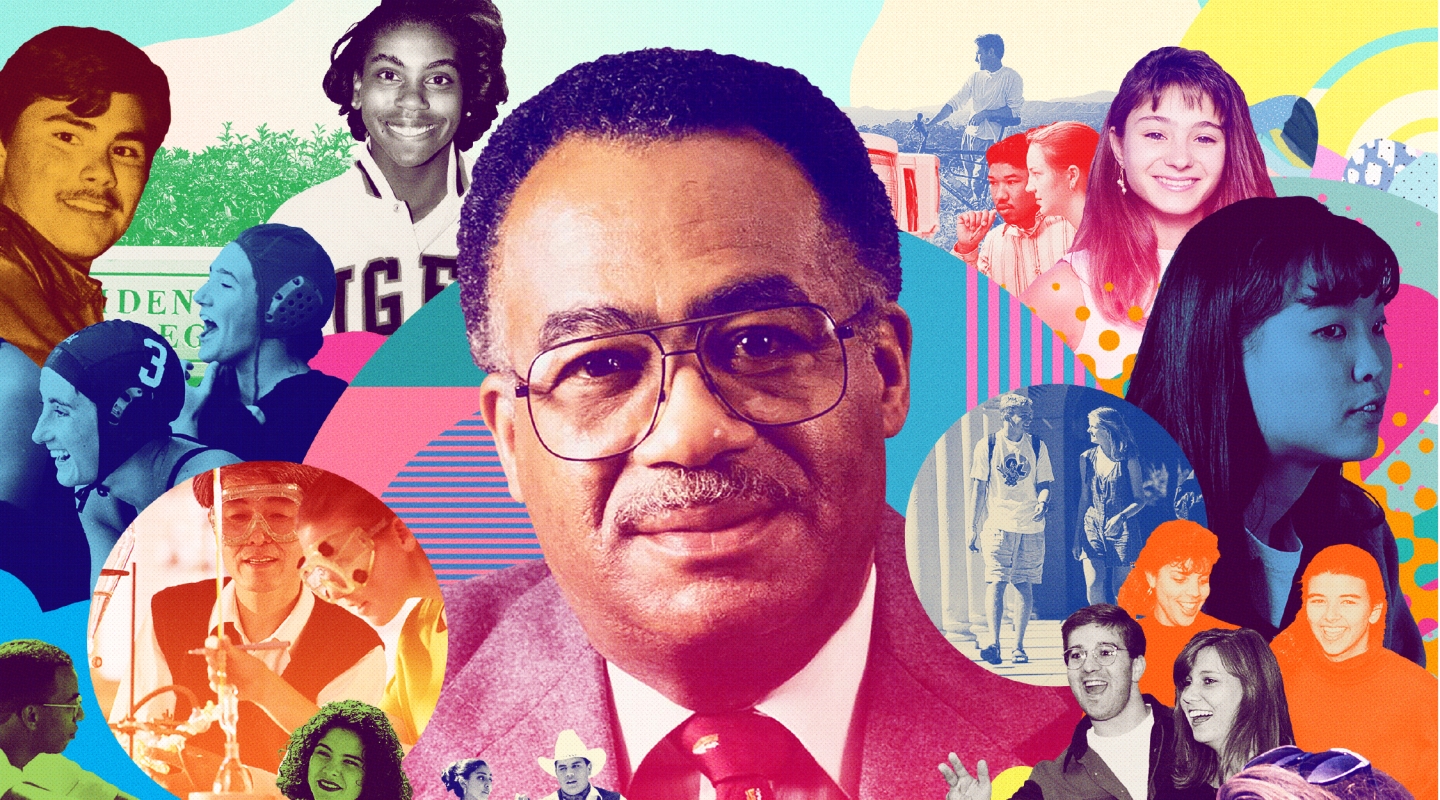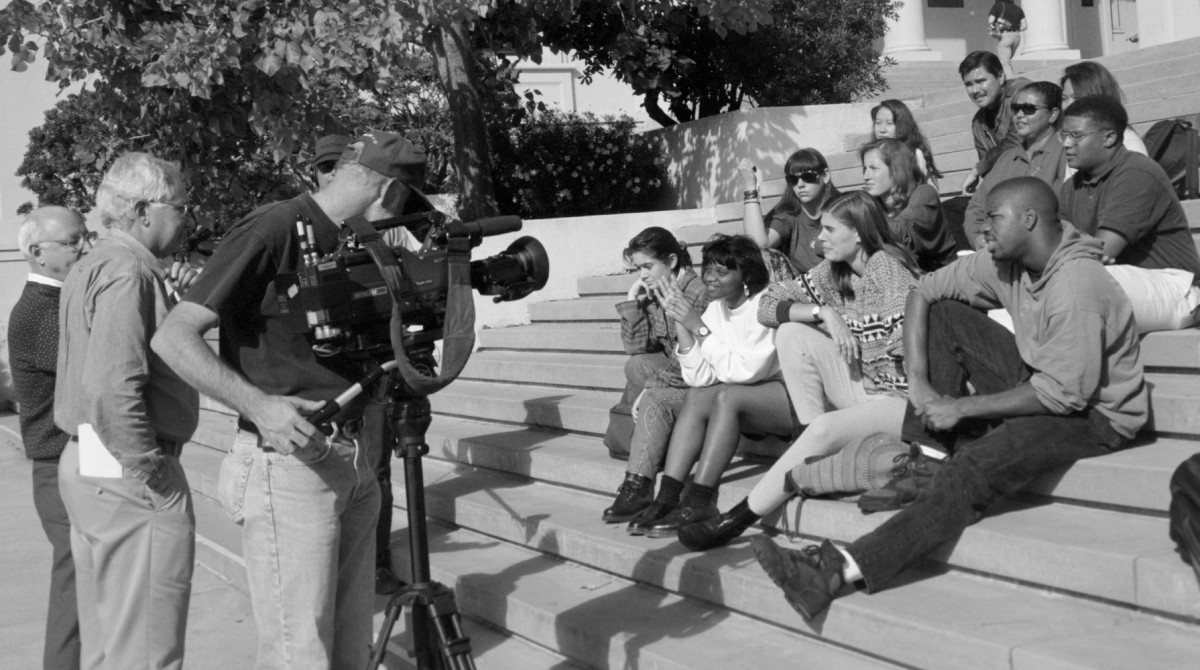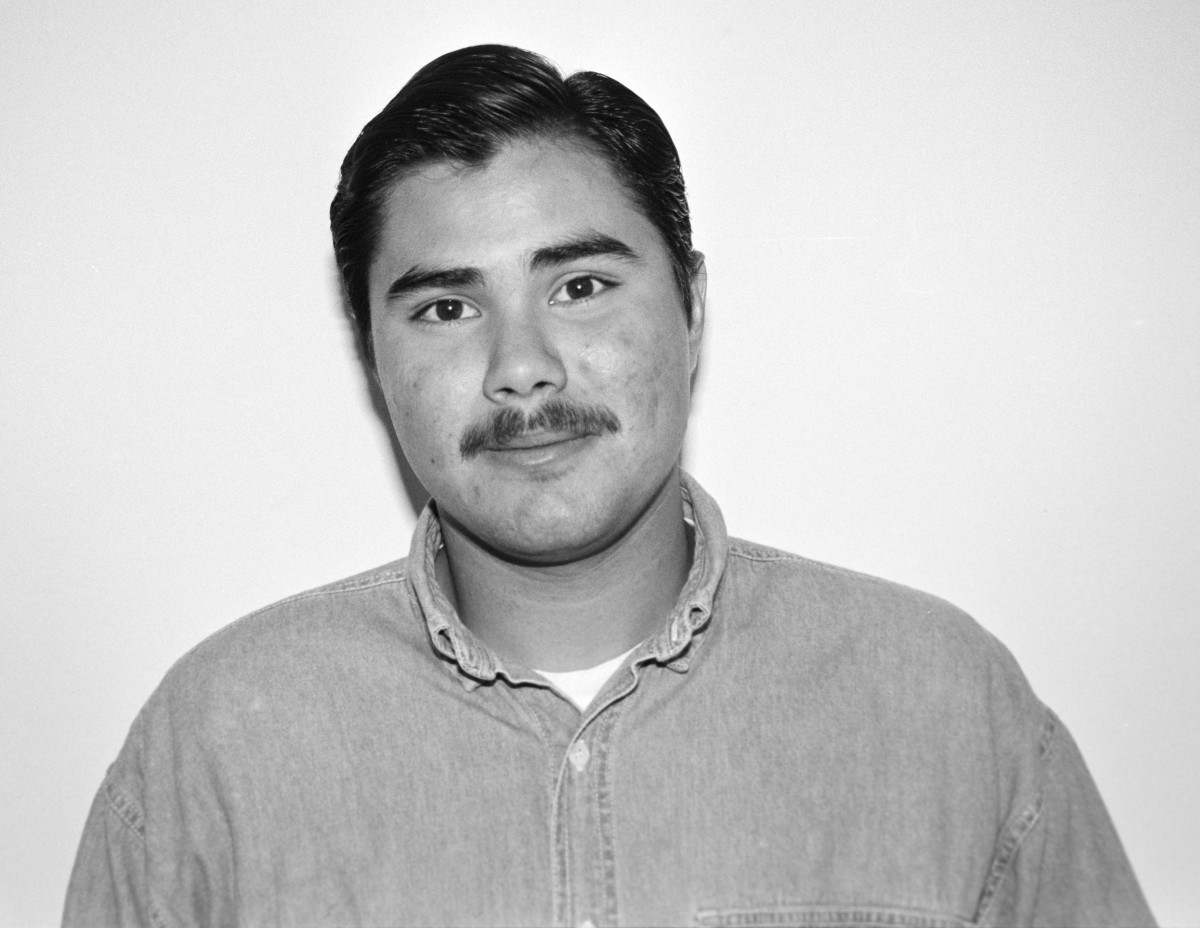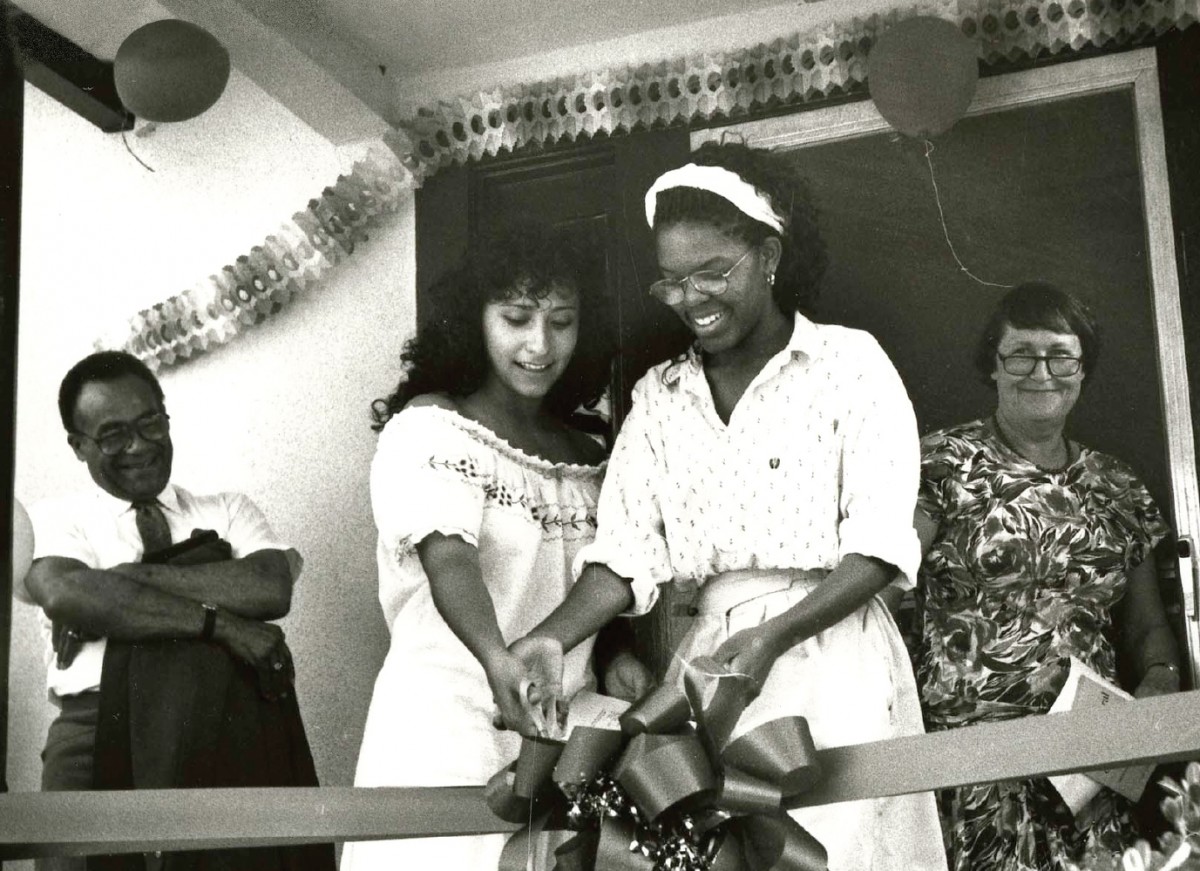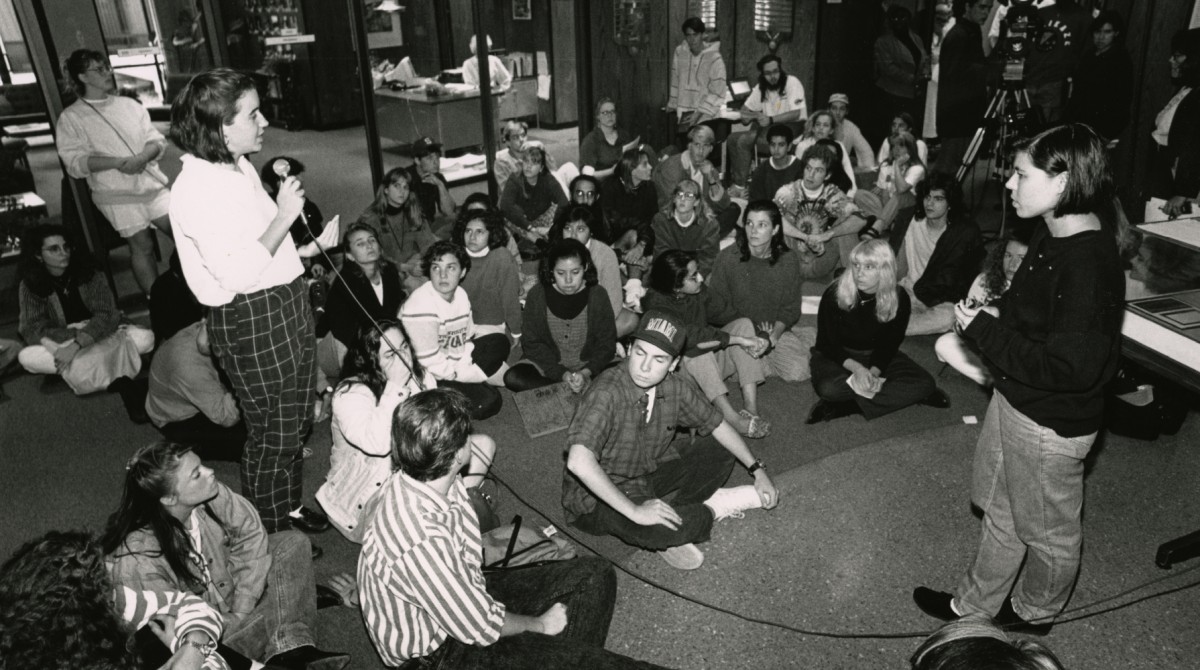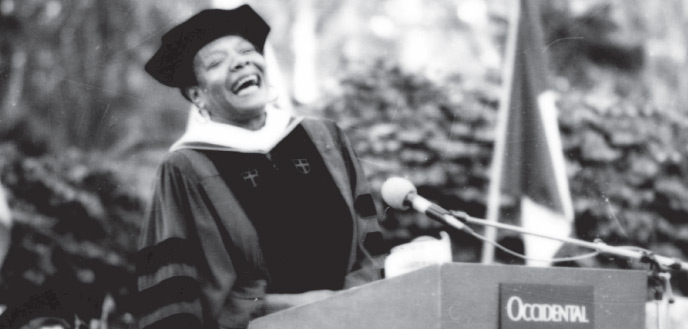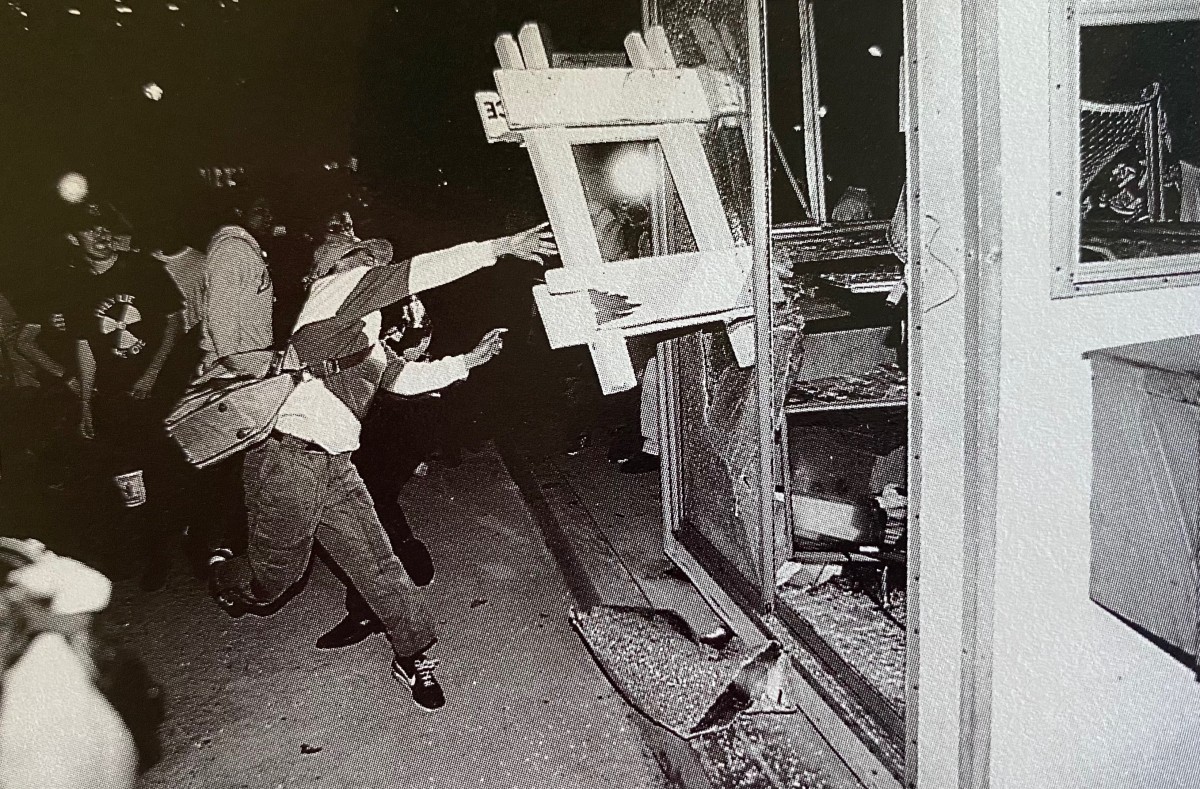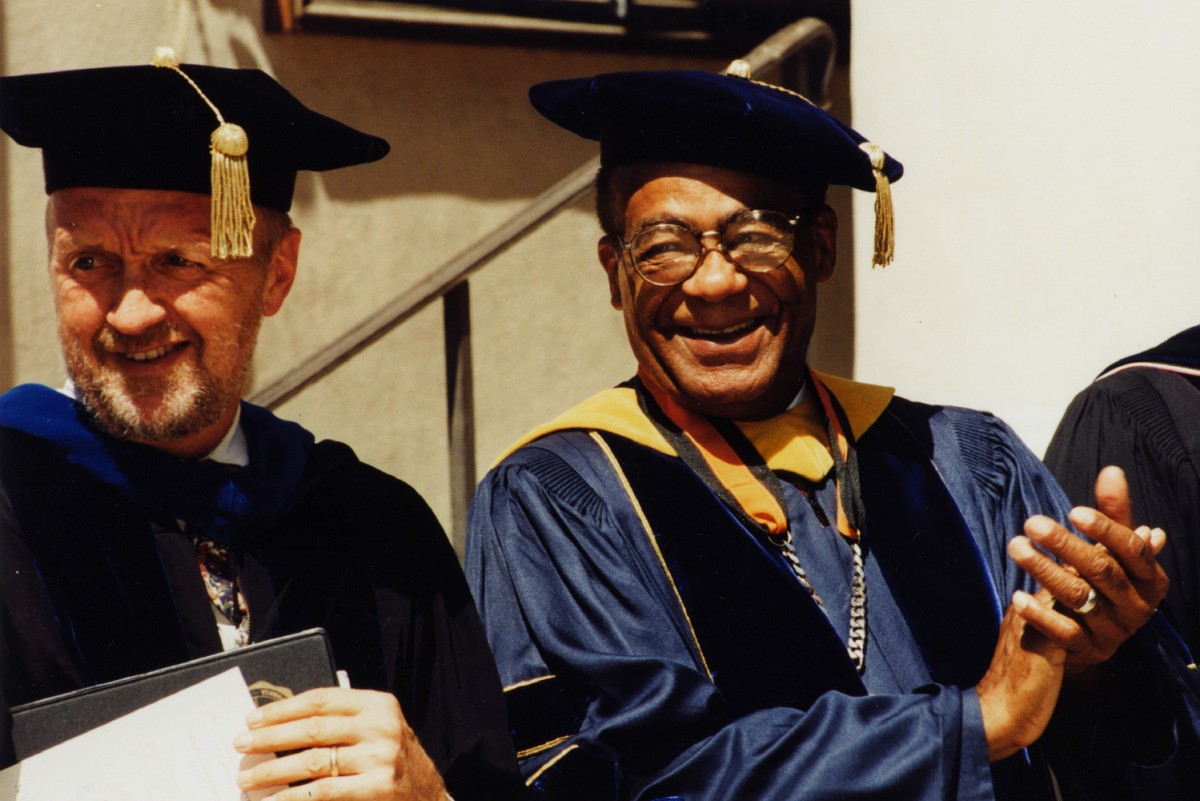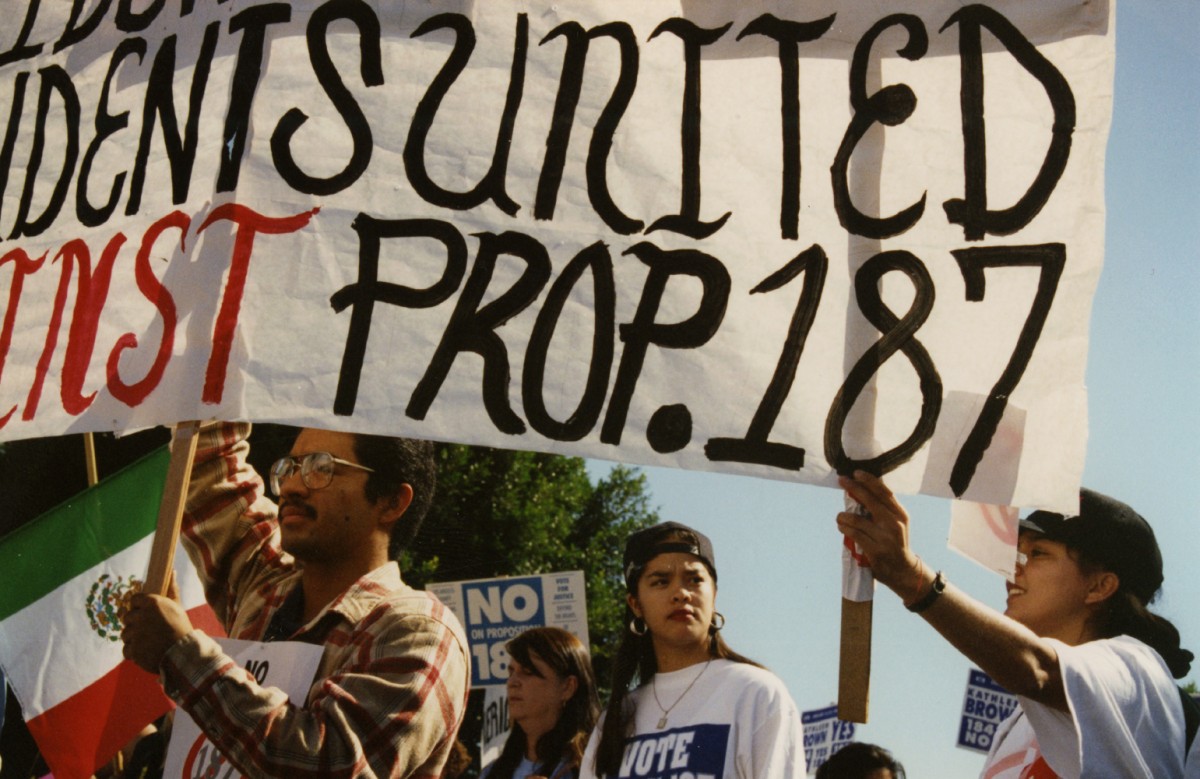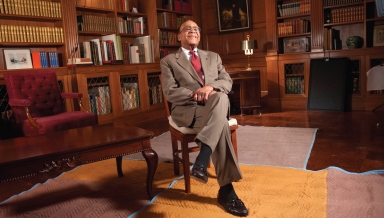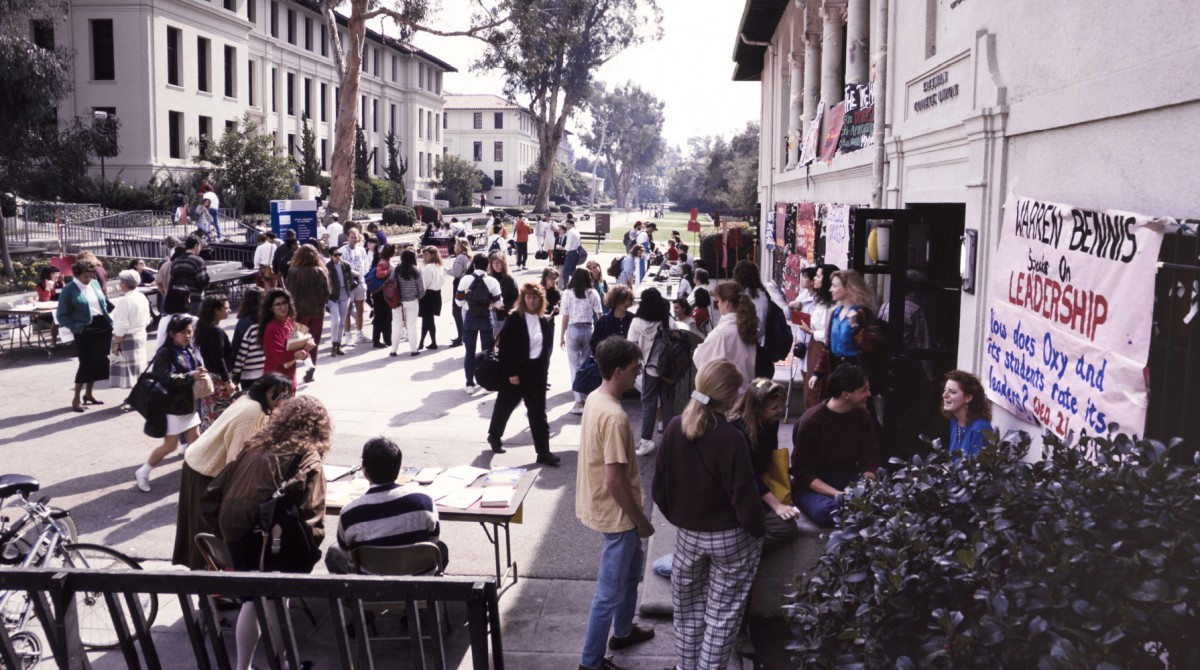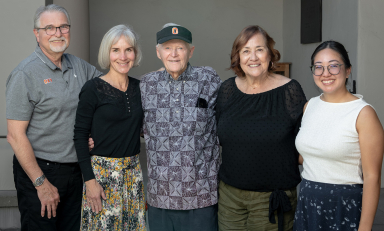As its second century dawned, Occidental welcomed a bold new president, adopted a mission Of Excellence and Equity, and brought a diversity of voices to the classroom. How did the changes impact the College?
Long before he arrived at Occidental, Leo Olebe ’97 was asking questions about identity. “I’m a Black man with a white mother and a Black father,” the native Kenyan explains. “My entire life has been questions about cultural identity, racial identity, and ethnicity.” In looking at colleges, he adds, “It was really important to find a place where I could learn more about myself but then also just fit in and be accepted.”
Just before Thanksgiving during his first semester at Oxy, Olebe was among a group of 11 students who sat down for an interview with CBS Sunday Morning correspondent Terence Smith on the steps outside Johnson Hall. The topic was multiculturalism.
“That overall conversation was all about trying to understand how different groups of people could come together and interact with each other and be respectful of their backgrounds and their ideas and work together to create a new version of society, if you will,” Olebe recalls.
Put another way, that was Oxy’s commitment to Of Excellence and Equity—the mission adopted by the College in 1990 that continues to this day. Talking to Smith, President John Brooks Slaughter—near the midpoint of his 11-year tenure—called Los Angeles “a city of a tremendous amount of rich diversity. For an institution to be in the middle of it, as Occidental College is, and not be more representative of that seemed incongruous.”
Addressing changes to the curriculum that alienated scores of Oxy alumni who endured two years of History of Civilization (a mainstay of the College curriculum from 1947 to 1970), Slaughter insisted, “We’re not going to replace one history with another one.” Western civilization, he continued, “didn’t come out of some big bang that occurred west of London. It came about from the infusion of ideas that came from Asia and from Africa and from Latin America and from a variety of sources. It was not something that came only from the Romans and the Greeks.”
Although their time at Oxy only intersected by one year, Cervantes and Olebe share a number of other distinctions: Both served as ASOC president their senior year (Cervantes being the first Latino to do so), and both would occupy the administrative building for multiple days to address Oxy’s commitment to issues surrounding multiculturalism.
“It’s interesting imagining where the world is today, filled with challenges and problems and opportunities for change,” Olebe says. “But we were at the forefront of present-day thinking, in terms of trying to create an environment where diversity and inclusion were paramount, where we had conversations and pursued equity and inclusion. That’s the conversation that we started having back in the ’90s at Oxy.”
For much of the 1990s, the news stories coming out of Los Angeles were less than optimal: the L.A. uprising of 1992, the Northridge earthquake of 1994, and gang violence in East L.A. made many parents wary of sending their children out west. “I think we can conclude that while we had an edge and sense of momentum in the 1990s, it was not L.A.’s golden era,” Zócalo Public Square publisher Gregory Rodriguez observed in a 2016 forum.
Reflecting the impact of current events and natural disasters, the College was facing an admission shortfall that began in 1993 and bottomed out in 1996, resulting in an overall enrollment dip of nearly 10 percent in just three years, as well as a budget deficit that surfaced in 1989 and snowballed over the next few years. The latter necessitated cuts to staffing and programming as well as a change to the College’s need-blind financial aid program in 1994—which had been instrumental in diversifying the student body in those nascent years Of Excellence and Equity.
It’s a lot to digest, even with the benefit of hindsight. To make sense of the ’90s, we spoke recently to more than a dozen alumni and key administrators who experienced firsthand Oxy’s most transformative decade of the last 50 years. (To supplement these interviews, we drew on a number of oral histories conducted for an Oxy Corps project in 2012 and the CTSJ class in 2014. Those conversations are designated with an asterisk.)
“The 1990s were a period of continuity and change at Occidental,” says Eric Newhall ’67, professor of English emeritus (who also served as interim dean of students from 1993 to 1994). “We retained the best aspects of the pre-1990s Occidental and made changes that positioned us to educate undergraduates in the 21st century. In short, we tried to respect the past without living in the past.”
Living and Learning
When Cervantes arrived at Oxy in the fall of 1990, multiculturalism was front and center in the campus conversation. Oxy’s Multicultural Summer Institute had been founded three years earlier; Oxy’s Multicultural Center (since renamed the Intercultural Community Center) was dedicated in 1989, and the Multicultural Hall (Bell-Young), where Cervantes lived, was two years old.
There was room for civil discourse as well. Yvette Cabrera ’94, a history major from Santa Barbara, recalls a “South of the Border” party thrown by a fraternity where “they were having students crawl underneath a fence to get into the party.” MEChA/ALAS—short for Movimiento Estudiantil Chicano de Aztlán/Association of Latin American Students—found out about it, which led to discussions with fraternity members and Latino students through MEChA/ALAS. “Eventually the fraternity apologized,” Cabrera says.
“As students of color, we had to learn from each other, too—from students who came from different socioeconomic backgrounds,” she adds. “We were a campus that was not just trying to diversify but trying to change how and what we learned.”
Despite its new mission, Oxy administration wasn’t immune to criticism from the student body. On November 14, 1990, Alza la Raza, a hybrid rap concert, art show, and community festival in Hillside Theater hosted by the Black Student Alliance and ATO fraternity for community youth, was canceled by Dean of Students Brigida Knauer three days before the event, citing concerns over crowd size, security, and the prospect of gang fights. “The implication was, ‘People coming on campus is dangerous—I don’t know that we want that,’ ” recalls Ana Ramos-Sanavio ’93,* a history and art major from East L.A., who also lived in the Multicultural Hall.
“Pretty soon we had people sitting on the ground outside of her office, wrapping around toward the admission office, toward the stairs,” Ramos-Sanavio says. At 5 p.m., Knauer reportedly told them, “If you do not leave, you’re all going to have consequences.” “And we decided, ‘Well, we’re not leaving,’” Ramos-Sanavio says. “Before Campus Safety could lock the doors, some of us ran and got computers and blankets and whatever we needed to start deciding what we were going to do in there.” On the steps outside the building, there were maybe 200 students sleeping that first night in solidarity.
By the next day, with Knauer still refusing to meet them, the students had come up with a list of demands. “It was not just about that party that had been canceled, it became about a lot of other things,” Ramos-Sanavio says. “There was a Mortar Board at the time—I didn’t even know what they were about—but it was a very closed group, and it was mostly white males. We felt that wasn’t fair, so we demanded that it be more inclusive.” They also felt that the Occidental newspaper needed more representation of women, minorities, and the LGBT community.
The sit-in went on through the weekend and ended on Monday afternoon, November 19, when President Slaughter agreed to a discussion on student participation in policy making. “At the time we felt like, ‘We can do the 1960s all over again,’ so it was our chance to be a part of something,” Ramos-Sanavio says. “In the end [the administration] was willing to accept that there was all this energy going on, and they were willing to listen.”
Burning Questions
The 1991-92 academic year ended on a high note, with poet, activist, and national treasure Maya Angelou addressing the 424 graduating seniors and seven master’s degree recipients on June 14 in Hillside Theater. “How did you get here today?” she asked. “I’ll tell you how you got here. Lots of folks paid for you to get here. Lots of folks, way before you were born and way before you came of age, paid for you to get here.”It was a welcome reprieve in the aftermath of the L.A. uprising, barely six weeks earlier, which had resulted in 63 deaths, more than 12,000 arrests, and property damage of more than $1 billion.
“The L.A. riots were the backdrop to our freshman year,” says Billy Vela ’95*, a psychology major who grew up in Highland Park. “I still remember very clearly looking out from on top of Stearns or Haines or somewhere, and just seeing all of L.A. literally burning.”
In the wake of the uprising, Adam Portnoy ’93, a public policy major from Marblehead, Mass., and some of his classmates drove around the city, witnessing the looting firsthand (“You know, you’re in your early 20s, so you think you’re invincible—today I would not do something like this”).
Esther Teodoro ’95, a music and psychology double major from Seattle, remembers watching the fires burn “all night long” from a balcony on Stearns, and then walking down to the Quad the next day.
“It was 4 o’clock in the afternoon, but it was totally dark because of all the smoke and everything,” she says. “I’m Korean American, and seeing all the looting in Koreatown was so scary.”
The riots played out at Oxy “against the multicultural movement that was in full swing,” Vela says. “We weren’t all on the same page but people were able to express themselves. There were open forums.”
Speaking at a student-organized teach-in on May 6 in Thorne Hall, Slaughter said, “I am convinced that those of us on this small campus, this uncommon educational institution, are at the forefront of a dynamic movement in America, a movement that requires a commitment of people of good will to success; one that may fail, and if it does it will be a failure that will have dire consequences for generations.”
In the midst of all this, Peter Dreier—who at the time was a senior policy adviser to Boston Mayor Ray Flynn—interviewed with Oxy to be the newly endowed E.P. Clapp Distinguished Professor of Politics.
“A lot of my friends in Boston said, ‘Why would you want to go to L.A.? It’s burning down, it’s falling apart,’” Dreier recalls. “And I said, ‘This is going to be the most interesting city in America for the next 20 years,’ because of what the uprising basically suggested was going on. It was the most global of the American cities. It was the most diverse and it had elected a Black mayor [Tom Bradley] in a city with very few Black people. Clearly not everything was working but there was a lot of potential.”
When Dreier came out for an interview, “The smoke was still rising as I drove around L.A.—the National Guard were still in their Jeeps and they still had their guns and bayonets. It was both scary and hopeful at the same time, you know? Even though I turned down a possible job in L.A. six months earlier, the uprising changed my mind—that, plus Oxy’s commitment to addressing issues of economic and racial injustice. John Slaughter persuaded me that the College was changing with the times.”
Making Change Happen
From women to people of color, faculty diversity was in short supply when Slaughter arrived in 1988. (When he was hired, in fact, Oxy had only two African-Americans on the faculty—one of whom was a member of the presidential search committee.) Changing that became a top priority.
“We had a cohort of faculty members who were committed to the idea of making the curriculum more inclusive, and bringing in points of view that a year before had not been emphasized,” Slaughter told then-President Jonathan Veitch in a 2012 interview for Occidental magazine.
Axeen looks back on that period proudly. Most of Oxy’s faculty hires in the ’90s “really added something new to the College and they came from the best institutions in their fields. We had a five- or six-year string through the ’90s where we got our first choice in every faculty search. We had a sense that we were on the edge of something—that we were gathering forces to move forward in a positive way.
“When you’re learning as you’re doing, as we all were, it gave a special energy to what was going on,” he adds. “When I quit being dean, the faculty we had recruited was something like 20 to 25 percent people of color—but the tenured faculty was 50 percent women by the end of the decade.”
Emerita professor Lynn Dumenil, who left Claremont McKenna College in 1991 to become the Robert Glass Cleland Professor of American History at Oxy, recalls, “There were so many interesting meetings believe it or not, about teaching. The College was trying to help faculty address issues of race, racism, sexism, and the like, and I found the conversations really exhilarating.
“I certainly thought the students were wonderful,” she adds. (Dumenil retired in 2014.) “It was kind of amazing that the College was ahead of the curve—in part, by recognizing that the nature of the age group was going to change over time. I still think that Occidental’s commitment to social justice persists but that heritage is from the ’90s.”
Commitment Issues
Bolstered by a $1 million grant from the James Irvine Foundation in 1989, Oxy expanded its outreach program to potential applicants from a host of economic, ethnic, and geographic backgrounds. By 1993, more than half the entering class at Occidental was non-white. But that benchmark was hard to hold for a host of reasons, not the least of which was the competition.
When Axeen would go to nationwide deans’ meetings, his peers often asked him questions as to how Oxy achieved diversity. “About halfway through the ’90s, they stopped asking and started doing it themselves,” he says. “In some ways, we were the victims of our own success—which is great. We won’t make the world better if we’re the only ones doing it.”
Truong saw multiculturalism as a leveling presence: “that chance to be in the same residence hall, to pick the same classes, to sit down at Clancy’s together. That was the preciousness of that opportunity.”
Those opportunities didn’t come without a cost, and as ASOC president her senior year, Olga (Garcia) Rodriguez ’95 recalls, “There were going to be significant cuts to the College’s budget. In trying to figure out what areas to cut, everything was assessed. I was the voice of the student body, and students were very angry about the cuts. I definitely felt that more things were brewing, like how committed is Oxy to multiculturalism, and to bringing in students from different backgrounds?”
Those concerns came to a boil in the 1995-96 academic year, when nearly 150 students staged a sit-in in the AGC in support of the “permanent institutionalization of multiculturalism at Occidental.”
“My memory is that we were protesting a decrease in the racial diversity of the newly admitted class,” says sit-in participant Sam Sharp ’96, a biology and politics double major from Denver. “That brought into question Oxy’s commitment to diversity.”
On April 17, 1996, just as the sit-in was beginning, Olebe was being installed by trustee Don Cornwell ’69 as ASOC president. He exited the ceremony to join his girlfriend inside the administration building. “I wasn’t the organizer of the sit-in, but the role that I played was the negotiator,” he recalls. “There was a list of 12 demands—I don’t remember what they all were. But at its core, it was about multiculturalism and believing that multiculturalism was so important to the history and the vibe of the College that we were willing to stand up and fight for it.”
“Students come to Oxy with very high expectations that this is going to be diversity heaven—or as close to a utopian, diverse college as you can get,” says Dreier, who taught classes outside the building during the sit-in. “They’re confronted with the reality that Oxy lives in the real world, and that racism and economic injustice do not disappear when you walk onto campus.”
“I looked at those sit-ins—and I think John did too—as challenges from people with whom maybe we weren’t communicating well enough,” Axeen says. “We didn’t take it personally. We wanted the students to be energetic and engaged and involved.”
“We were just a bunch of students waking up to the world and trying to make a difference,” Olebe says. “That’s what was so cool about Occidental—that you could follow your hearts and try to change the world.”
End of the Road
On June 3, 1998, Slaughter announced his decision to retire as Oxy president effective June 30, 1999. “It is with an unwavering sense of pride that I can say that these 10 years have been well spent—it has been a time when the Occidental community has proven time after time that quality and equality are the hallmark of Occidental,” he wrote in the magazine.
Many students were wary of what it meant for the College’s commitment to its mission; a front-page headline in The Occidental in September 1998 asked, “Has Multiculturalism Been Slaughtered by Trustee Agenda?” The president’s answer: No.
“Many people are under the mistaken notion that multiculturalism began when I arrived,” Slaughter told writer Amber Engelson ’02. “One of the reasons I chose Oxy was because of its strong background in multiculturalism. … Multiculturalism will continue as it always has.”
Even now, rumors persist in some circles that Slaughter didn’t leave on his own terms, but there’s no evidence to suggest that was the case. “There was a sense that some people had that 11 years was a long tenure for a president, and it is above the median,” Axeen says. “John didn’t talk to me about his decision [in advance]—and if he had, I would have urged him to stay.”
What is certain is that Slaughter left the College a very different place than it was when he arrived. The new J. Stanley and Mary W. Johnson Student Center, a cornerstone of Oxy’s capital campaign, opened months before his departure. Although down from its mid-’90s peak, student diversity remained strong—and with the hiring of Bill Tingley in 1997, the College’s admission numbers rebounded quickly without compromise.
“Oxy could have chosen a less difficult path, at least in the short term,” Newhall says. “We could have gotten smaller and just recruited the top SAT scores and been that kind of institution. But I like the fact that we opted to look more like the city of Los Angeles.”
Today, Portnoy says, “Multiculturalism almost sounds like an antiquated term, but back then it was really forward thinking. And I think President Slaughter was a decade or two ahead of where everybody else eventually ended up getting.”
“John Brooks Slaughter was such a hero of mine,” says Eddie Jauregui ’98, a public policy major from Carson. “He had a lot of challenges that were laid at his feet but I think a lot of students of color in particular really admired that man. I certainly did.”
“I wasn’t actually aware of Oxy’s focus on multiculturalism until I was there,” says Shannon Brueckner ’95, a psychology major from Bakerfield, who is now a marriage and family therapist in Walnut Creek. “That was one of the most impactful aspects of my education—everything from core curriculum classes to heated debates in the Quad. It really opened my eyes and provided a foundation for future work for me to build on.”
More Than Words
When Oxy surveyed alumni in 2019 about their attitudes, a sizable cohort from the 1990s agreed that “a diverse and inclusive environment has a significant impact on their overall opinion of Oxy.” The work they are doing in the world reinforces that belief.
“That’s a significant contribution to society in government that has really changed the dynamics of healthcare policy,” she adds proudly. “I attribute it to my Oxy years, to how I was trained, and to John Slaughter’s Of Excellence and Equity. I didn’t have to make an excuse for not having the highest SAT score in my class. I was just moving on and trying to improve the world.”
For Olebe, who recently became Google's new managing director of play partnerships for games, “Being able to think critically about how people can come together and how you have to respect other cultures, other ideas, different ways of solving problems—I literally use that every day,” he says. “I also spend a lot of my time giving back."
During his 5½-year stint at Facebook, “We launched a Black gaming creator program where we’re trying to give them the opportunity to let their voice shine," he continues. "I did a lot of things around Pride Month, Women’s History Month, and Latinx and Hispanic Heritage Month, as well as raising money for veterans, mental health, and World Down Syndrome Day. It’s all about: How do you use your privilege and your position in the world to make a difference and drive positive change?”
As a writer and editor on the student newspaper, Cabrera says, “I was able to speak my mind and have a voice at a time when I was still finding my way as a journalist at Occidental. It taught me that you can change the system when you’re part of the system.” She is currently a senior staff writer for Grist, focusing on issues of environmental justice.
After starting her career in public relations in the entertainment industry, Teodoro is a principal at Seattle-based BigGigs, which creates high-impact events for corporations, public agencies, and nonprofits. “I truly recognize and appreciate the significance of having that multicultural experience in college, what it did for me as a person, how that has affected my worldview and the actions that I take as a result of it,” she says. “It’s uncomfortable and it’s painful but I don’t shy away from having difficult conversations. Unfortunately, I have a lot of personal experience of what it’s like to be faced with racism, but I’m not afraid of it anymore.”
Sharp leads the special district group at Piper Sandler, a leading investment bank, with a focus on infrastructure projects in Colorado. “I definitely feel like I have a framework of analytical thought and an ethical belief system that were framed in my time at Oxy,” says Sharp, who is also a member of the College’s equity and justice committee and on the chief diversity officer search committee.
“President Slaughter’s vision of multiculturalism really permeated the school,” he adds. “Having a clear, defined framework for teaching and fostering values of diversity and inclusion was instilled from Orientation through graduation. It was ubiquitous on campus in a way that we’re trying to replicate now with a deeper focus on equity and justice.”
“Most of us loved Oxy—the classes, the professors,” says Cervantes, a teacher in the Los Angeles Unified School District, professor at Glendale Community College, and co-founder of the Latino/a Scholarship Fund following his graduation 27 years ago. (He’s also the 2021 recipient of the Alumni Seal Award for service to the College.) “There’s a lot of good sentiment from my era. It was a good time to be here.”
Among the faculty changemakers of that era, emeriti professors Axeen, Newhall, Mike McAleenan (sociology), and Norman Cohen (history) remain close friends. During the pandemic, they formed a remote book group. “We agree on an academic book,” McAleenan says, “and every two weeks we get on Zoom for a two-hour session and debate the book.” Many of their discussions center on issues of race, class, gender, and inclusion, he adds, “So we’re still at it in our own minds.”

